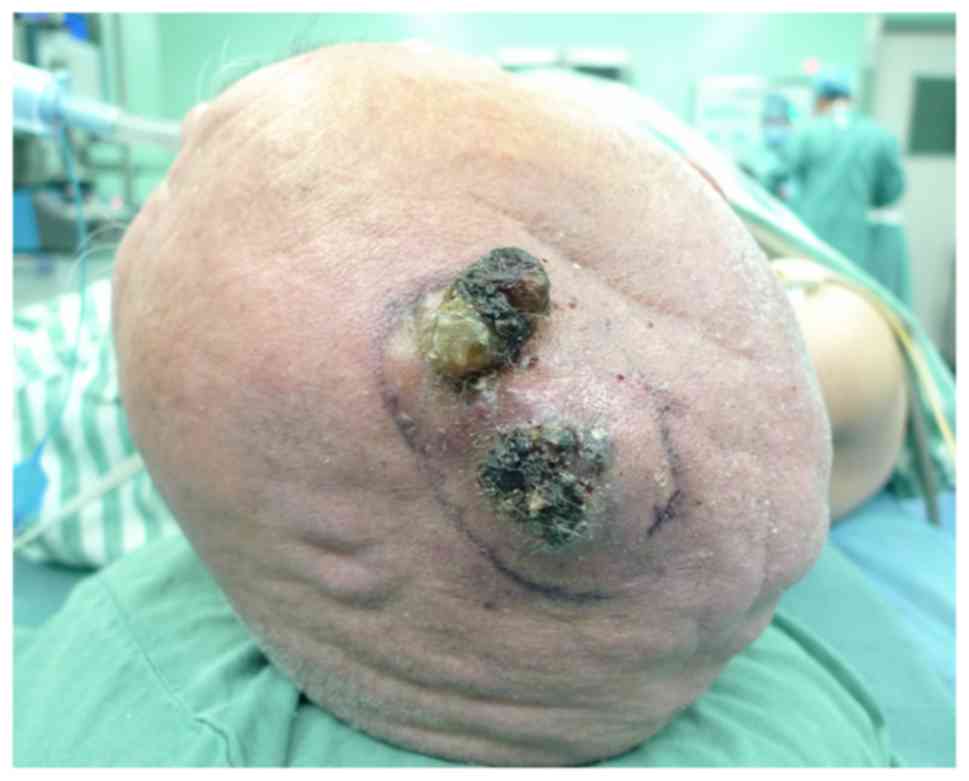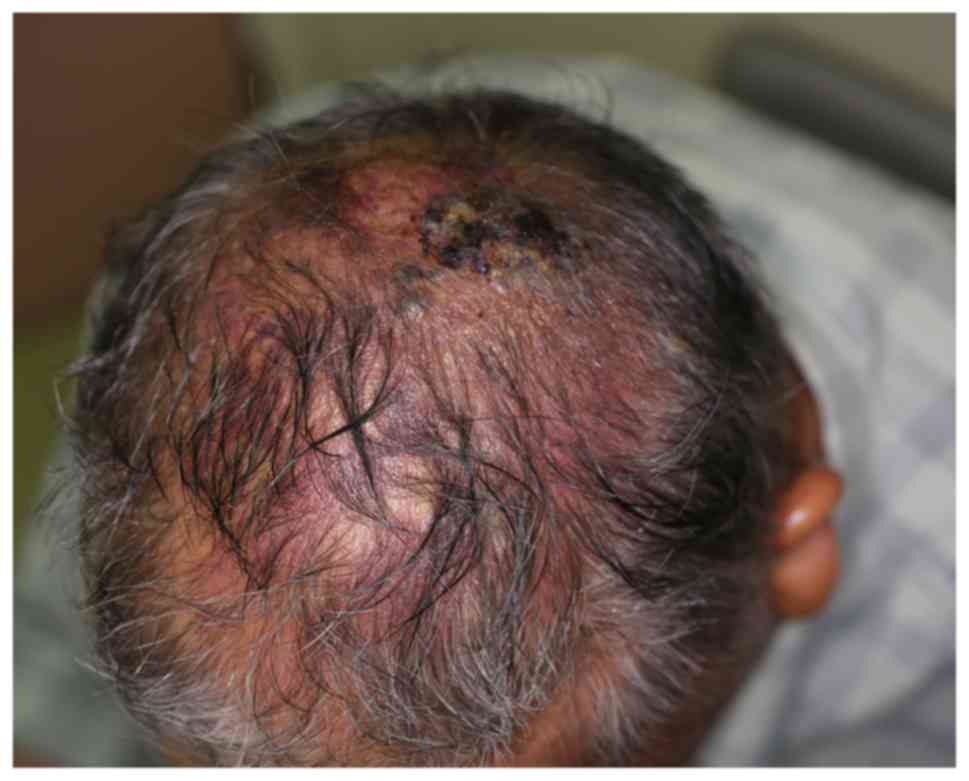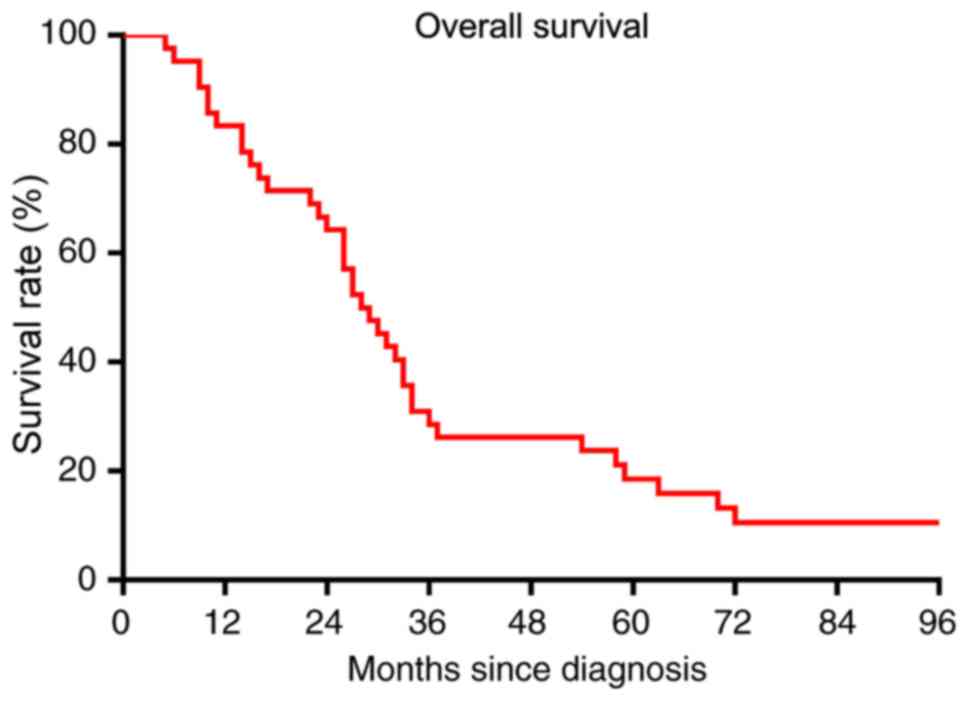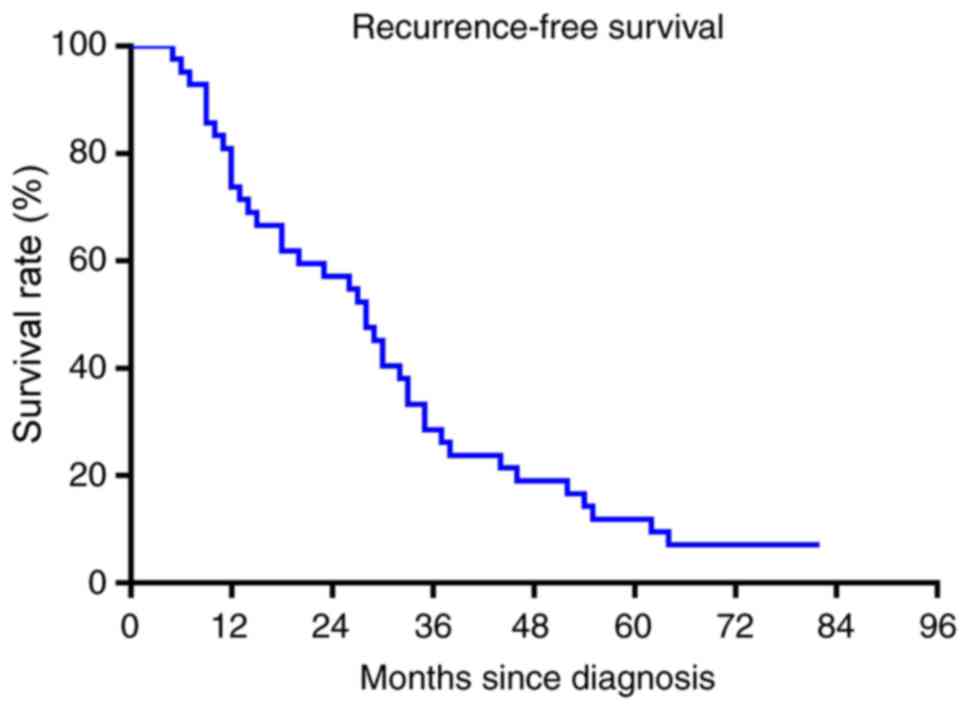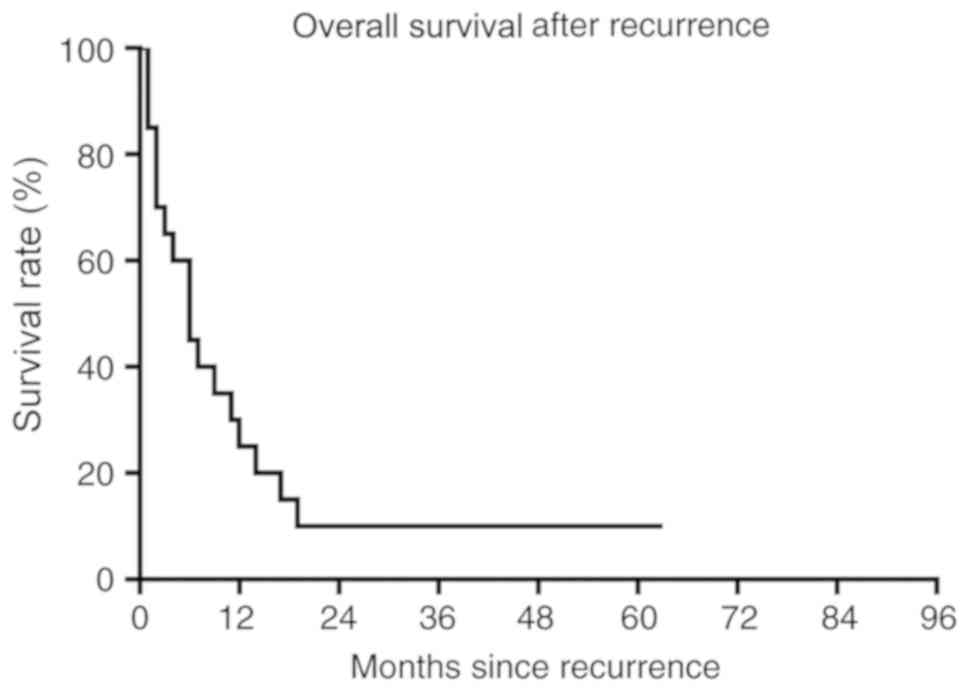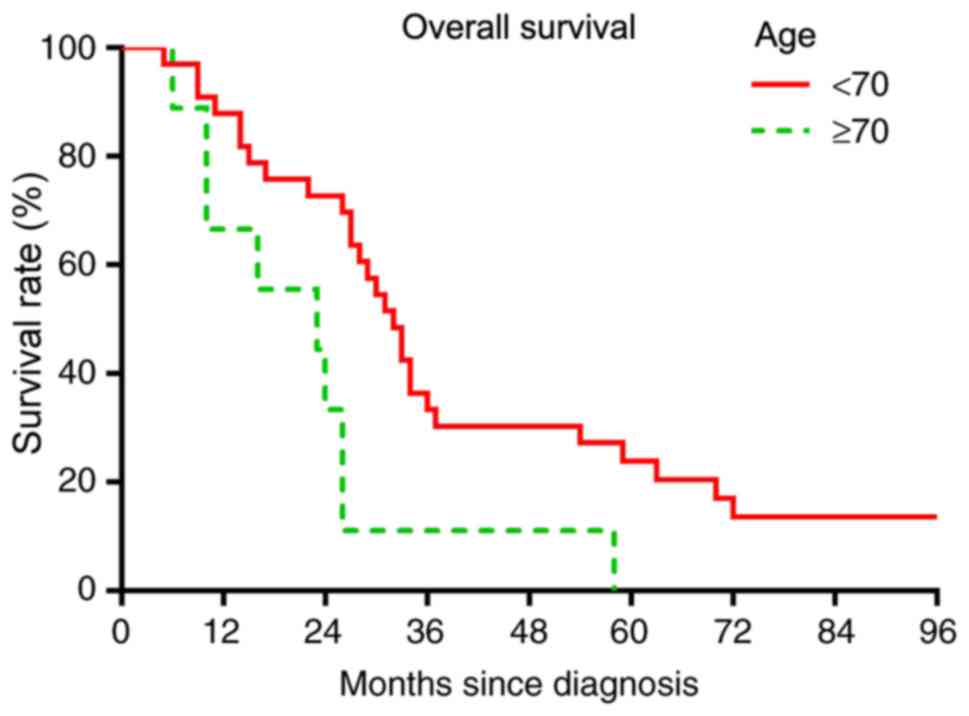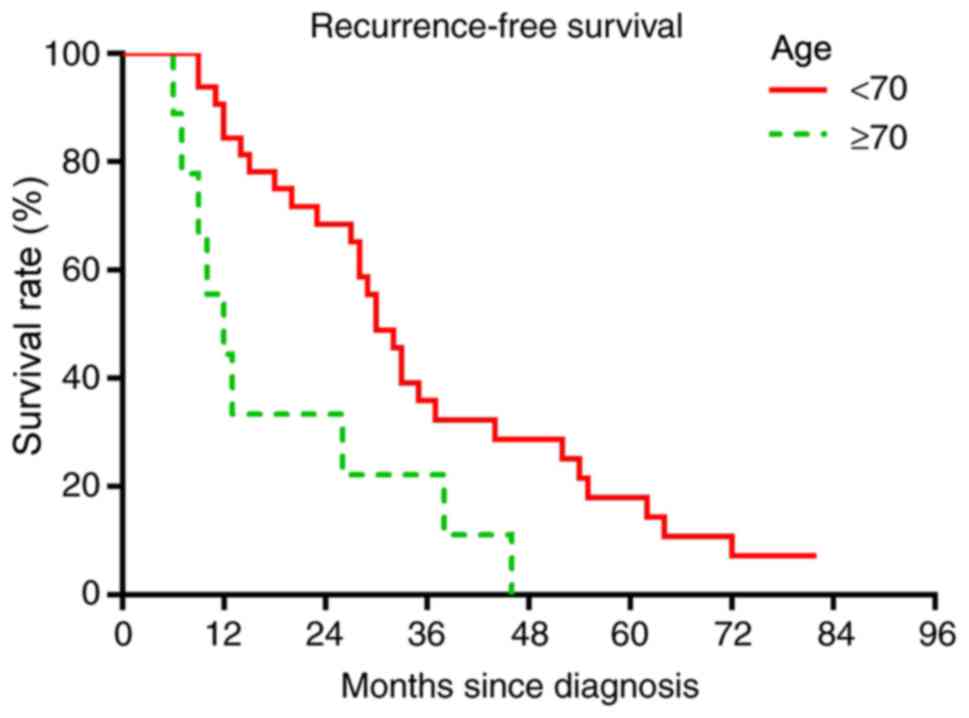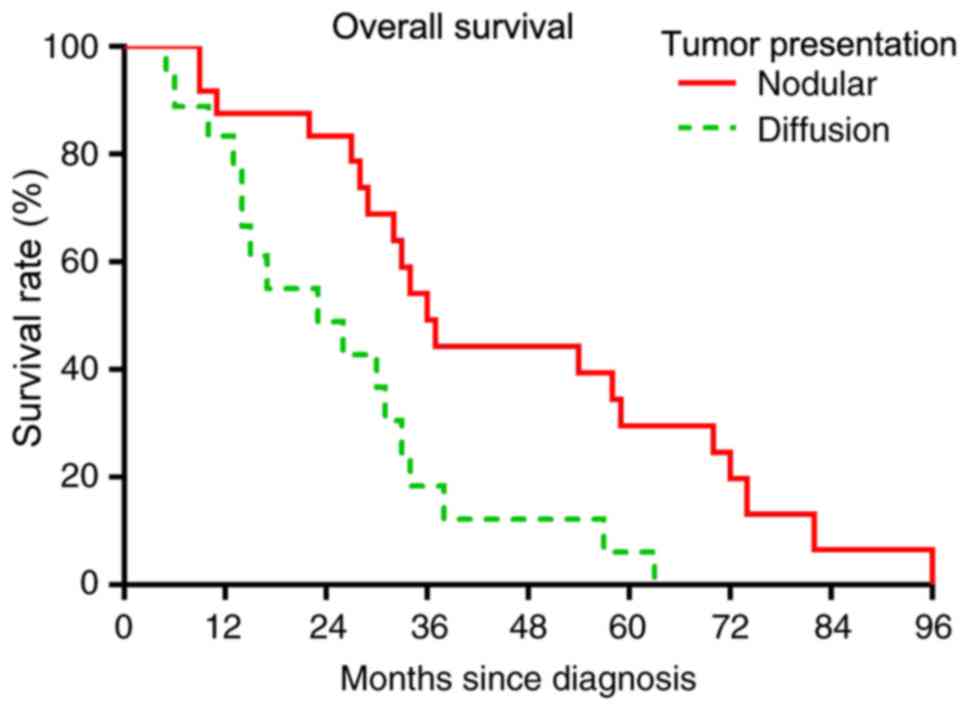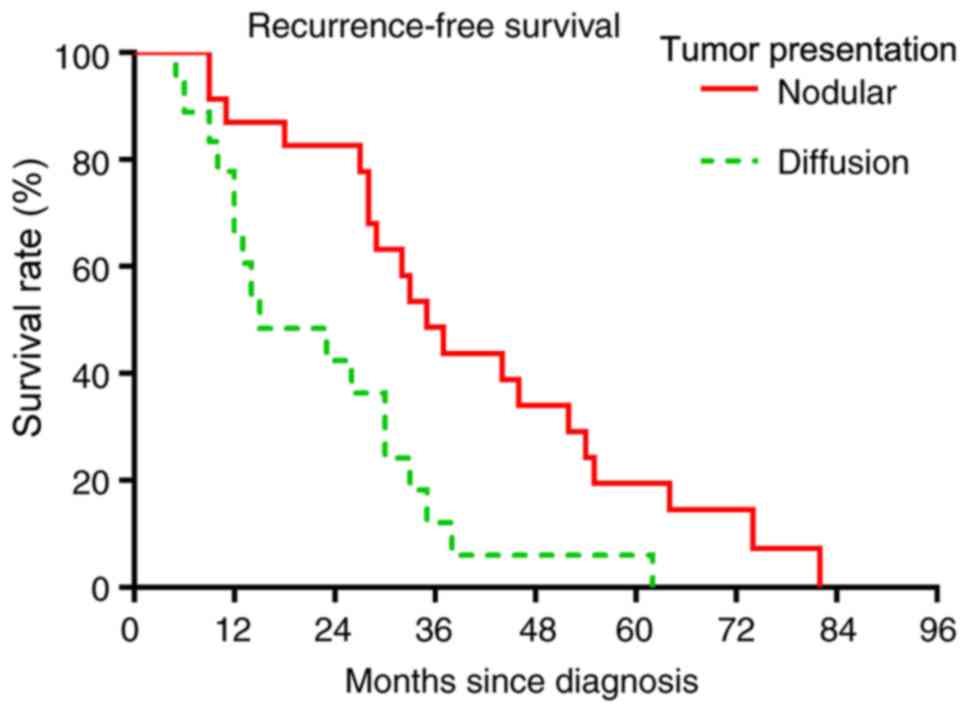Introduction
Cutaneous angiosarcomas are aggressive tumors that
arise in either the blood or lymphatic vessels, and account for
~15% of all head and neck sarcomas and 1% of all soft tissue
sarcomas (1). Cutaneous angiosarcoma
has a reported 5-year overall survival (OS) rate between 9 and 30%
(2–4). The scalp and face are the most common
sites of cutaneous angiosarcoma (4).
Previous studies investigated the survival outcomes for cutaneous
angiosarcoma of the scalp vs. face, and the results have indicated
that scalp angiosarcoma has a worse survival rate compared with
facial angiosarcomas (2,4). However, the present study focused on
the outcomes of scalp angiosarcoma; therefore, patients with facial
angiosarcomas were excluded.
Scalp angiosarcoma has an innocuous presentation
(5,6). Complete surgical resection with wide
margins is preferred for loco-regional disease (7). Chemotherapy is widely used in patients
with lesions that cannot be entirely resected, or who have distant
metastatic disease (7). However, the
optimal treatment for patients with scalp angiosarcoma has not yet
been defined.
Due to its low incidence, the available literature
on scalp angiosarcoma primarily consists of case reports, and few
large single institution series on scalp angiosarcoma have been
published (5,6,8). In the
present analysis, a relatively large cohort study was performed,
where 42 patients with scalp angiosarcoma were diagnosed and
treated at a monocenter (Zhongshan Hospital, Fudan University) over
a period of 12 years. The present study analyzed patient and tumor
characteristics, as well as treatment algorithms. The potential
associations between these parameters and patient outcomes were
investigated.
Materials and methods
Ethics approval and consent to
participate
After Institutional Review Board (Ethics Committee
of Zhongshan Hospital) approval was obtained, the present study
performed a retrospective review, which included all patients
diagnosed with and treated for scalp angiosarcomas at Zhongshan
Hospital, Fudan University (Shanghai, China), between January 2002
and December 2013. A total of 42 patients were included in the
present study, 25 (60%) were male and 17 (40%) were female, and the
patient age at the time of diagnosis age ranged between 19 and 82
years (median, 60 years). Written informed consent was obtained
from all patients and/or family members. Cases with an unclear
histological diagnosis and without a complete medical history were
excluded from the present study. Patients with facial angiosarcoma,
Stewart-Treves and angiosarcoma on trunk or extremities were also
excluded.
Patient and disease
characteristics
Epidemiological data including patient demographics,
tumor characteristics (such as location, size and margin status),
tumor grade, treatment parameters, and outcome (local recurrence
and metastases) were obtained and analyzed. Tumor grade was
stratified into two groups; low and high, as described previously
(8). Among these patients, 25 (60%)
were male and 17 (40%) were female, and the patient age at the time
of diagnosis age ranged between 19 and 82 years (median, 60 years).
Based on the type of lesion, patients were divided into a nodular
localized lesion group (Fig. 1) and
a diffuse lesion group (Fig. 2). The
tumor presented as a nodular localized lesion in 25/42 patients
(60%) and as a diffuse lesion in 17/42 patients (40%). OS and
recurrence-free survival (RFS) rates were listed.
Patients included in the present research provided
their complete medical history, underwent a complete physical
examination, routine laboratory tests and appropriate imaging
examinations (computed tomography and magnetic resonance imaging)
prior to undergoing treatment. Through a review of the pathology
slides, a diagnosis of angiosarcoma was histologically confirmed in
each case by two pathologists affiliated to Zhongshan Hospital
(Fudan University) at the time of patient presentation.
Percentages were used to describe characteristics of
patients, disease and treatment algorithms. OS and RFS rates were
calculated and compared with those described in published
literature (8). OS rate was
calculated as the time from the date of diagnosis to the date of
patient mortality. RFS rate was calculated as the time from date
the patient was considered disease-free to the date of recurrence
or mortality. Multimodality therapy was defined for treatment
presenting ≥2 modalities including surgery, radiation and
chemotherapy.
Statistical analysis
Continuous variables were presented as mean ±
standard deviation or median with range and interquartile range
depending on their distribution. Categorical variables were
presented as frequency and percent. Kaplan-Meier analysis was used
to calculate actuarial curves for OS and RFS rates, and a log-rank
test to compare survival. A Cox proportional hazard model was used
for multivariate analysis to test the predictive ability of
clinical variables. The χ2 or Fisher exact test was used
to test for differences between proportions for categorical
variables. P<0.05 was considered to indicate a statistically
significant difference. Unless otherwise stated in the text, all
P-values were two-sided. All statistical analyses were performed
using SPSS 22.0 software (IBM Corp.).
Results
Patient and disease
characteristics
The patient characteristics are presented in
Table I. A total of 42 cases were
clearly documented and served as the cohort for this analysis. In
all patients, the primary lesions were located on the scalp. The
tumor presented either as a nodular localized lesion in 25/42
patients (60%) or as a diffuse lesion in 17/42 patients (40%). The
present study recorded characteristics such as gross tumor size.
The maximal dimension ranged between 2 and 9 cm, and the size was
≤5.0 cm in 19 patients (45%) and >5.0 cm in 23 patients (55%),
with a median size of 6.0 cm. Patients did not exhibit any signs of
distant metastatic disease outside the scalp at the time of
diagnosis.
 | Table I.Characteristics of 42 patients with
scalp angiosarcoma treated at Zhongshan Hospital Fudan
University. |
Table I.
Characteristics of 42 patients with
scalp angiosarcoma treated at Zhongshan Hospital Fudan
University.
| Characteristic | Patients, n (%) |
|---|
| Sex |
|
| Male | 25 (60) |
|
Female | 17 (40) |
| Age, years |
|
|
<70 | 33 (79) |
| ≥70 | 9 (21) |
| Tumor size, cm |
|
| ≤5 | 19 (45) |
|
>5 | 23 (55) |
| Tumor
presentation |
|
|
Nodular | 25 (60) |
|
Diffusion | 17 (40) |
| Local therapy |
|
| Surgery
alone | 12 (29) |
| Radiation
alone | 0 (0) |
|
Chemotherapy alone | 0 (0) |
| Target
therapy alone | 3 (7) |
| Combine therapy |
|
|
Surgery+chemotherapy | 14 (33) |
|
Surgery+radiation | 6 (14) |
|
Surgery+chemotherapy+radiation | 7 (17) |
Treatment
Definitive surgical resection was the most common
therapeutic measure, and was performed in 39 (93%) patients, alone
(12 patients), in combination with chemotherapy (14 patients),
radiotherapy (6 patients) or 3-modality-therapy (7 patients). The
remaining three patients received targeted therapy with apatinib.
When treatment algorithms included surgery, chemotherapy and
radiotherapy, the chemotherapy and radiotherapy were administered
post-operatively. Surgical resection margins were at >3 cm,
wherever possible, around any visible or palpable tumor. Graft or
flap reconstruction was performed in patients who received
surgery.
Combination of surgery, chemotherapy and
radiotherapy was performed in 7 patients. Radiation therapy was
delivered to the entire scalp post-operatively in 13 (31%)
patients. The median radiotherapy dose for patients treated with
radiotherapy following surgery was 45 Gy (range, 40.0–60.0 Gy). A
total of 21 (50%) patients received chemotherapy as an adjuvant
treatment. Adjuvant chemotherapy consisted of doxorubicin liposomes
in 16 patients and cyclophosphamide alone in 5 patients. A total of
3 (7%) patients received apatinib as the sole treatment. No severe
complications associated with treatments were detected.
Patient outcomes
The median follow-up time of patients was 28.5
months (range, 5–107 months). A total of 37 (88%) patients
succumbed to mortality from angiosarcoma of the scalp. The 2-, 3-
and 5-year OS rates were 64, 29 and 19%, respectively (Fig. 3). A total of 23 (55%) patients
experienced tumor recurrence. The RFS rate was 55, 26 and 10% at 2,
3 and 5 years, respectively (Fig.
4). At 1- and 3-years following recurrence, the OS rate was 25
and 10%, respectively (Fig. 5). Only
two patients developed distant metastasis in the lungs.
Based on multivariate analysis, no treatment factors
were significantly predictive of worse OS or RFS rates (data not
shown). In the univariate analysis, patients aged ≥70 years had a
significantly worse OS rate (P=0.0071; Fig. 6) and a worse RFS rate (P=0.0095;
Fig. 7). Among tumor
characteristics, only patients whose tumor presented as a nodular
localized lesion had a significantly improved OS (P=0.0079;
Fig. 8) and RFS (P=0.0041; Fig. 9) rates. Prognostic factors including
tumor presentations, tumor size, tumor grade and treatment
algorithms indicated that no factor was significantly predictive of
tumor recurrence. In addition, no significant differences were
observed between the responses of different tumor presentations to
chemotherapy or radiation (Table
II).
 | Table II.Univariate analysis of overall
survival rate and recurrence-free survival rate in 42 patients with
scalp angiosarcoma treated at Zhongshan Hospital Fudan
University. |
Table II.
Univariate analysis of overall
survival rate and recurrence-free survival rate in 42 patients with
scalp angiosarcoma treated at Zhongshan Hospital Fudan
University.
| Variable | Patients, n
(%) | 5-year OS, % | P-value | 5-year RFS, % | P-value |
|---|
| Sex |
|
| 0.177 |
| 0.092 |
|
Male | 25 (60) | 23 |
| 18 |
|
|
Female | 17 (40) | 11 |
| 0 |
|
| Age, years |
|
| 0.007 |
|
|
|
<70 | 33 (79) | 23 |
| 15 | 0.010a |
|
≥70 | 9 (21) | 0 |
| 0 |
|
| Tumor
presentation |
|
| 0.003 |
| 0.004a |
|
Nodular | 24 (57) | 29 |
| 19 |
|
|
Diffusion | 18 (43) | 6 |
| 0 |
|
| Tumor grade |
|
| 0.936 |
| 0.987 |
|
Low | 12 (29) | 17 |
| 13 |
|
|
High | 30 (71) | 15 |
| 15 |
|
| Tumor size, cm |
|
| 0.979 |
| 0.961 |
| ≤5 | 19 (45) | 16 |
| 12 |
|
|
<5 | 23 (55) | 15 |
| 15 |
|
| Local therapy |
|
| 0.517 |
| 0.683 |
| S | 12 (29) | 25 |
| 25 |
|
|
S+RT | 6 (14) | 0 |
| 0 |
|
| Multimodality
therapy |
|
| 0.587 |
| 0.628 |
|
S+C | 14 (33) | 14 |
| 7 |
|
|
S+RT | 6
(14) | 0 |
| 0 |
|
|
S+RT+C | 7
(17) | 15 |
| 0 |
|
Discussion
Scalp angiosarcoma is a malignant aggressive head
soft tissue neoplasm often with an innocuous presentation (5,6). Despite
ongoing researches, the treatment options for angiosarcoma are
limited, and even following aggressive therapy, patient survival is
very poor (2,7). Therefore, timely and accurate diagnosis
of this disease is critical in order to ensure an optimal patient
outcome. However, initial diagnosis is often difficult due to a
lack of definitive symptoms (8).
In the present study, the 5-year OS rate was 19%,
and the 5-year RFS rate was 10%, with these demographic results
being similar to previous reports (4,9–11). A total of 23 (55%) patients
experienced disease recurrence, and this result was consistent with
a previously reported case (12). In
our surgical practice, it was noted that patients with nodular
tumor presentation usually had definitive local resection, while
patients with diffuse presentation usually had uncertain margins
that may be associated with recurrence. Other institutional reviews
of angiosarcoma revealed that there was no significant difference
in rates of loco-regional recurrence among the different tumor
presentations or treatment modalities (7,13).
Guadagnolo et al (9) reported
that tumor size >5 cm was significantly indicative of a worse
prognosis for OS rate; however, the present study did not observe a
statistically significant association between these two
parameters.
In the present study, only two (5%) patients
developed distant metastasis. This low distant metastatic rate was
inconsistent with previously reported cases (10,11).
This inconsistency may be due to the fact that an autopsy was not
performed in the majority of cases, therefore some metastases may
have been neglected.
It has been previously reported that angiosarcoma
can be caused by therapeutic radiation or chronic lymphedema;
therefore, secondary breast angiosarcomas are an important subgroup
of angiosarcomas (14). However, in
the present study, no patients presented with a history of
radiotherapy or chronic lymphedema. In the department of Plastic
and Reconstructive Surgery, Zhongshan Hospital (Shanghai, China),
the most commonly observed presentation of angiosarcoma was on the
scalp.
Morgan et al (15) demonstrated that a positive surgical
margin was associated with poor OS in 44 patients with angiosarcoma
of the face and scalp. However, in the current literature, the
implication of surgical margins on the outcome of scalp
angiosarcoma is still debated, and multiple studies did not
identify such correlation (4,7,9). In the present study, surgical resection
margin for visible tumor was at ≥3 cm. This extended resection
aimed to obtain negative surgical margin status, which coincided
with literature that supported the role of curative-intent surgery,
irrespective of the histological surgical margin status (16). Reconstructive options involve skin
grafting, local pedicled and axial flaps, and microsurgery for
complex and extensive wound reconstruction (13). If bone invasion was not present, the
skull periosteum and graft skin were retained (12).
Current treatment for angiosarcomas of the scalp,
face and neck typically involves surgery and neoadjuvant/adjuvant
chemotherapy (4,7). In this study, it was noted that no
patients survived without chemotherapy treatment, suggesting that
chemotherapy played an important part in angiosarcoma research. The
study by Chow et al (17)
reported that monotherapy with the β-blocker propranolol was
capable of reducing the proliferative index of a cutaneous
angiosarcoma. In the study conducted by Singla et al
(18), patients received
paclitaxel-based regimens. Similarly, Schlemmer et al
(19) reported that patients with
advanced angiosarcoma who were treated with paclitaxel had a
significantly improved survival. However, no assumptions can be
made pertaining to the OS from these studies. Gebhardt et al
(20) reported that complete
remission of treatment-refractory advanced scalp angiosarcoma
occurred following protracted intralesional interleukin-2 therapy.
Young et al (21)
investigated vascular-targeted agents, including bevacizumab [an
anti-vascular endothelial growth factor (VEGF) antibody], axitinib
[a VEGF receptor (VEGFR) tyrosine kinase inhibitor], everolimus (an
mTOR inhibitor), selumetinib (a mitogen-activated protein kinase
kinase inhibitor) and vadimezan (a vascular-disrupting agent) on
cutaneous angiosarcoma cell lines, showing positive responses.
However, a subsequent clinical study indicated that patients did
not benefit from VEGF/VEGFR targeted treatment (22). Additional studies with expanded
patient populations are necessary to fully examine the adjuvant
natures of these agents in the setting of other therapeutic
regimens. In the present study, three patients received apatinib, a
tyrosine kinase inhibitor that selectively inhibits VEGFR2;
however, it did not significantly improve the outcome of the
patients.
The complete pathogenesis of angiosarcoma remains
unknown, and it is still a matter of debate whether angiosarcomas
are derived from blood or lymph vessels or their progenitors
(23). In recent years, multiple
studies have sought to establish the molecular pathogeneses of
angiosarcomas and identify specific targets for its treatment: Wada
et al (24) investigated the
effect of inhibitors of the PI3K/AKT/mTOR pathway using ISOS-1 and
ISO-HAS angiosarcoma cell lines, and demonstrated that the
phosphoinositide-dependent kinase 1 (PDK1) inhibitor was a
promising therapeutic agent. In addition, Tsuneki et al
(25) identified an agent named
survivin as a promising biomarker and critical regulator of
cellular proliferation for angiosarcoma using human angiosarcoma
specimens, and also suggested that YM155 may function as a
potential therapeutic agent.
However, there are limitations to the present study,
as it was retrospective regarding data collection, and could be
influenced by the inherent bias of study design. The present study
spanned over a period of 12 years, and has been accompanied by
rapid advances in the treatment modalities. Therefore, selection
bias may be involved due to the heterogeneous treatment. In
conclusion, the present study indicates that scalp angiosarcoma is
an aggressive malignancy with a high mortality rate and poor
prognosis. Despite the fact that the exact mechanisms underlying
angiosarcoma remain unclear, the research on cutaneous angiosarcoma
genomics is preliminary but consistent (26).
Acknowledgements
Not applicable
Funding
The present study was supported from the National
Natural Science Foundation of China (grant no. 81802724).
Availability of data and materials
All data generated or analyzed during this study are
included in this published article.
Authors' contributions
JL, YY, MZ, CC, NL, FQ and YZ designed and performed
the experiments, analyzed the data and wrote the paper. All authors
read and approved the final version of the manuscript.
Ethics approval and consent to
participate
The study was approved by the Ethics Committee of
Zhongshan Hospital, Shanghai, China. Written informed consent was
obtained from all patients and/or family members.
Patient consent for publication
All patients provided written informed consent for
the publication of the present study and images.
Competing interests
All authors declare that they have no competing
interests.
References
|
1
|
Wanebo HJ, Koness RJ, MacFarlane JK,
Eilber FR, Byers RM, Elias EG and Spiro RH: Head and neck sarcoma:
Report of the Head and Neck Sarcoma Registry. Society of Head and
Neck Surgeons Committee on Research. Head Neck. 14:1–7. 1992.
View Article : Google Scholar : PubMed/NCBI
|
|
2
|
Bernstein JM, Irish JC, Brown DH,
Goldstein D, Chung P, Razak A, Catton C, Gilbert RW, Gullane PJ and
O'Sullivan B: Survival outcomes for cutaneous angiosarcoma of the
scalp versus face. Head Neck. 39:1205–1211. 2017. View Article : Google Scholar : PubMed/NCBI
|
|
3
|
Mendenhall WM, Mendenhall CM, Werning JW,
Reith JD and Mendenhall NP: Cutaneous angiosarcoma. Am J Clin
Oncol. 29:524–528. 2006. View Article : Google Scholar : PubMed/NCBI
|
|
4
|
Pawlik TM, Paulino AF, McGinn CJ, Baker
LH, Cohen DS, Morris JS, Rees R and Sondak VK: Cutaneous
angiosarcoma of the scalp: A multidisciplinary approach. Cancer.
98:1716–1726. 2003. View Article : Google Scholar : PubMed/NCBI
|
|
5
|
Ye J, Li XF, Wang YD and Yuan Y: Long-term
survival of a patient with scalp angiosarcoma and multiple
metastases treated using combination therapy: A case report. Oncol
Lett. 9:1725–1728. 2015. View Article : Google Scholar : PubMed/NCBI
|
|
6
|
Lin SC and Chang TS: Cutaneous
angiosarcoma of the scalp mimicking facial cellulitis. Ear Nose
Throat J. 95:438–440. 2016. View Article : Google Scholar : PubMed/NCBI
|
|
7
|
Fury MG, Antonescu CR, Van Zee KJ, Brennan
MF and Maki RG: A 14-year retrospective review of angiosarcoma:
Clinical characteristics, prognostic factors, and treatment
outcomes with surgery and chemotherapy. Cancer J. 11:241–247. 2005.
View Article : Google Scholar : PubMed/NCBI
|
|
8
|
Perez MC, Padhya TA, Messina JL, Jackson
RS, Gonzalez RJ, Bui MM, Letson GD, Cruse CW, Lavey RS, Cheong D,
et al: Cutaneous angiosarcoma: A Single-Institution experience. Ann
Surg Oncol. 20:3391–3397. 2013. View Article : Google Scholar : PubMed/NCBI
|
|
9
|
Guadagnolo BA, Zagars GK, Araujo D, Ravi
V, Shellenberger TD and Sturgis EM: Outcomes after definitive
treatment for cutaneous angiosarcoma of the face and scalp. Head
Neck. 33:661–667. 2011. View Article : Google Scholar : PubMed/NCBI
|
|
10
|
Ogawa K, Takahashi K, Asato Y, Yamamoto Y,
Taira K, Matori S, Iraha S, Yagi N, Yogi A, Haranaga S, et al:
Treatment and prognosis of angiosarcoma of the scalp and face: A
retrospective analysis of 48 patients. Br J Radiol. 85:e1127–e1133.
2012. View Article : Google Scholar : PubMed/NCBI
|
|
11
|
Patel SH, Hayden RE, Hinni ML, Wong WW,
Foote RL, Milani S, Wu Q, Ko SJ and Halyard MY: Angiosarcoma of the
scalp and face: The Mayo clinic experience. JAMA Otolaryngol Head
Neck Surg. 141:335–340. 2015. View Article : Google Scholar : PubMed/NCBI
|
|
12
|
Lee BL, Chen CF, Chen PC, Lee HC, Liao WC,
Perng CK, Ma H and Lin CH: Investigation of prognostic features in
primary cutaneous and soft tissue angiosarcoma after surgical
resection: A retrospective study. Ann Plast Surg. 78 (Suppl
2):S41–S46. 2017. View Article : Google Scholar : PubMed/NCBI
|
|
13
|
Abraham JA, Hornicek FJ, Kaufman AM,
Harmon DC, Springfield DS, Raskin KA, Mankin HJ, Kirsch DG,
Rosenberg AE, Nielsen GP, et al: Treatment and outcome of 82
patients with angiosarcoma. Ann Surg Oncol. 14:1953–1967. 2007.
View Article : Google Scholar : PubMed/NCBI
|
|
14
|
Young RJ, Brown NJ, Reed MW, Hughes D and
Woll PJ: Angiosarcoma. Lancet Oncol. 11:983–9891. 2010. View Article : Google Scholar : PubMed/NCBI
|
|
15
|
Morgan MB, Swann M, Somach S, Eng W and
Smoller B: Cutaneous angiosarcoma: A case series with prognostic
correlation. J Am Acad Dermatol. 50:867–874. 2004. View Article : Google Scholar : PubMed/NCBI
|
|
16
|
Oashi K, Namikawa K, Tsutsumida A,
Takahashi A, Itami J, Igaki H, Inaba K and Yamazaki N: Surgery with
curative intent is associated with prolonged survival in patients
with cutaneous angiosarcoma of the scalp and face - a retrospective
study of 38 untreated cases in the Japanese population. Eur J Surg
Oncol. 44:823–829. 2018. View Article : Google Scholar : PubMed/NCBI
|
|
17
|
Chow W, Amaya CN, Rains S, Chow M,
Dickerson EB and Bryan BA: Growth attenuation of cutaneous
angiosarcoma with propranolol-mediated β-blockade. JAMA Dermatol.
151:1226–1229. 2015. View Article : Google Scholar : PubMed/NCBI
|
|
18
|
Singla S, Papavasiliou P, Powers B,
Gaughan J, von Mehren M, Watson JC and Farma JM: Challenges in the
treatment of angiosarcoma: A single institution experience. Am J
Surg. 208:254–259. 2014. View Article : Google Scholar : PubMed/NCBI
|
|
19
|
Schlemmer M, Reichardt P, Verweij J,
Hartmann JT, Judson I, Thyss A, Hogendoorn PC, Marreaud S, Van
Glabbeke M and Blay JY: Paclitaxel in patients with advanced
angiosarcomas of soft tissue: A retrospective study of the EORTC
soft tissue and bone sarcoma group. Eur J Cancer. 44:2433–2436.
2008. View Article : Google Scholar : PubMed/NCBI
|
|
20
|
Gebhardt C, Ziegler B, Stadler S, Goerdt S
and Utikal J: Complete remission of treatment-refractory advanced
angiosarcoma of the scalp by protracted intralesional interleukin-2
therapy. Br J Dermatol. 172:1156–1158. 2015. View Article : Google Scholar : PubMed/NCBI
|
|
21
|
Young RJ, Woll PJ, Staton CA, Reed MW and
Brown NJ: Vascular-targeted agents for the treatment of
angiosarcoma. Cancer Chemother Pharmacol. 73:259–270. 2014.
View Article : Google Scholar : PubMed/NCBI
|
|
22
|
Young RJ and Woll PJ: Anti-angiogenic
therapies for the treatment of angiosarcoma: A clinical update.
Memo. 10:190–193. 2017. View Article : Google Scholar : PubMed/NCBI
|
|
23
|
Donghi D, Kerl K, Dummer R, Schoenewolf N
and Cozzio A: Cutaneous angiosarcoma: Own experience over 13 years.
Clinical features, disease course and immunohistochemical profile.
J Eur Acad Dermatol. 24:1230–1234. 2010. View Article : Google Scholar
|
|
24
|
Wada M, Horinaka M, Yasuda S, Masuzawa M,
Sakai T and Katoh N: PDK1 is a potential therapeutic target against
angiosarcoma cells. J DermatoL Sci. 78:44–50. 2015. View Article : Google Scholar : PubMed/NCBI
|
|
25
|
Tsuneki M, Kinjo T, Mori T, Yoshida A,
Kuyama K, Ohira A, Miyagi T, Takahashi K, Kawai A, Chuman H, et al:
Survivin: A novel marker and potential therapeutic target for human
angiosarcoma. Cancer Sci. 108:2295–2305. 2017. View Article : Google Scholar : PubMed/NCBI
|
|
26
|
Shustef E, Kazlouskaya V, Prieto VG, Ivan
D and Aung PP: Cutaneous angiosarcoma: A current update. J Clin
Pathol. 70:917–925. 2017. View Article : Google Scholar : PubMed/NCBI
|















